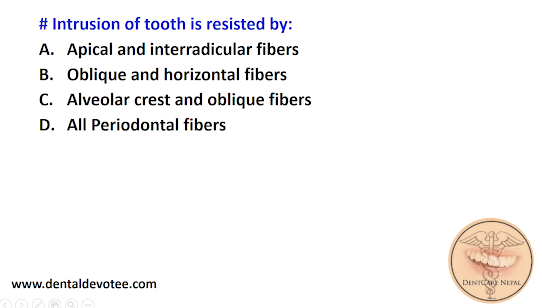# Intrusion of tooth is resisted by:
A. Apical and interradicular fibers
B. Oblique and horizontal fibers
C. Alveolar crest and oblique fibers
D. All Periodontal fibers
The correct answer is C. Alveolar crest and oblique fibers.
The principal fibers of periodontal ligament are arranged in six groups and are named according to their
location and direction of attachment.
1. Transseptal group
Location: These fibers run into the interproximal space over the crest of alveolar bone and get inserted in the cementum of neighboring tooth.
Function: They have the innate capacity to reconstruct themselves in periodontal disease even there is destruction of the alveolar bone. This unique property of fibers is responsible for returning teeth to their original state after orthodontic therapy.
2. Alveolar crest group (apico-oblique)
Location: Cervical root to alveolar crest of alveolar bone proper
Function: Prevent extrusion and lateral tooth movements
3. Horizontal group
Location: Mid root to adjacent bone proper
Function: Resists horizontal forces
4. Oblique group (coronal-oblique)
Location: Apical one-third of root to adjacent bone proper
Function: Resists vertical masticatory stresses and convert them into tension on alveolar bone
5. Apical group
Location: Apex of root to fundic proper
Function: Prevent tooth tipping, resist luxation and protect neurovascular supply to the tooth
6. Interradicular group
Location: Between roots to alveolar bone proper
Function: Prevent luxation, torquing and tooth tipping

Comments
Post a Comment
Add Your Comments or Feedback Here